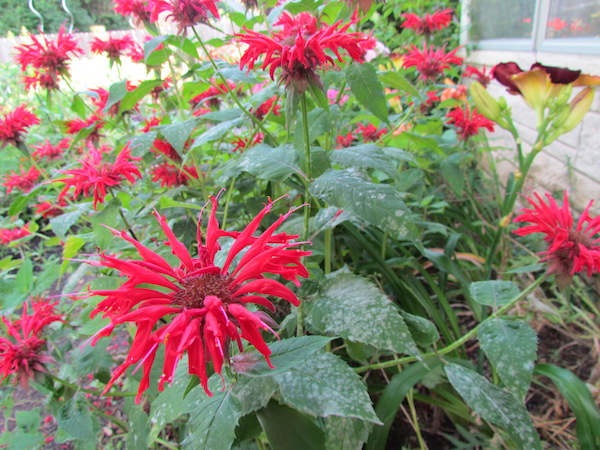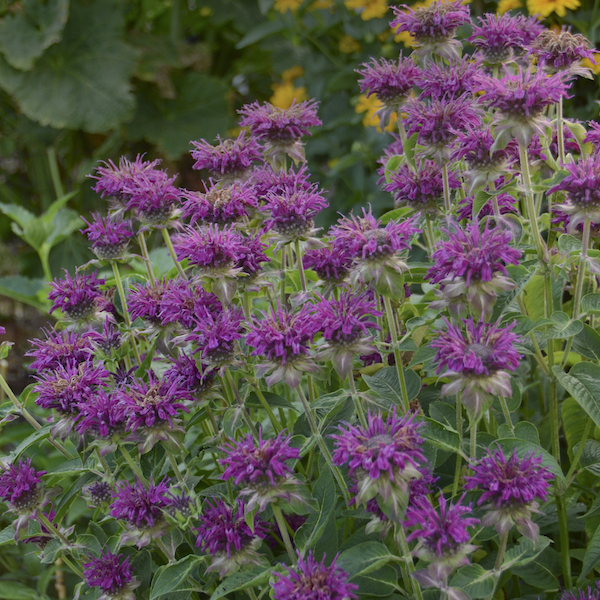
Powdery mildew is a common problem on many bee balms. (C) Jo Ellen Meyers Sharp
One of the perennials known to attract pollinators is bee balm (Monarda spp.). A member of the mint family, this aromatic plant attracts and supports at least 14 butterflies and moths, 13 bees and wasps and hummingbirds, finches, sparrows, catbirds.
“Today, people are increasingly aware that their landscapes provide not just beauty, but also play a role in improving the environment,” wrote George Coombs, research horticulturist at Mt. Cuba Center in Hockessin, Delaware, not far from Wilmington. “With the ability to support a multitude of different pollinators, Monarda is well positioned to capitalize on this growing trend and will continue to be a popular garden plant for years to come.”
Coombs’ group recently evaluated bee balms, and although the Delaware Piedmont is a different environment than our Midwest, the results can be a guide for our plant selections. At Mt. Cuba, 40 varieties of bee balms were trialed for three years. They were evaluated for their growth habit, leaf retention, flower coverage, and perhaps most importantly, resistance to powdery mildew. Powdery mildew is a common problem on bee balms, including several native varieties. Powdery mildew is a fungus that appears on monarda about the time it starts blooming. It is not usually deadly, but can cause leaves to dry, curl and fall off.

‘Purple Rooster’ was among the bee balms that showed resistance to powery mildew and good flower power. Photo courtesy PerennialResource.com
None rated excellent, or five stars, but there are several that received four and one-half stars: ‘Claire Grace’ (M. fistulosa), ‘Dark Ponticum’ and ‘Violet Queen’. Those that earned four stars: Grand Marshall, ‘Judith’s Fancy Fuchsia’, ‘Colrain Red’, ‘Raspberry Wine’, ‘Purple Rooster’, ‘On Parade’ and ‘Gardenview Scarlet’. My favorite, ‘Jacob Cline’ (M. didyma) scored slightly lower than the top performers, and could still be recommended, the Mt. Cuba Center report said. Many of the species also showed resistance to powdery mildew.
“The first signs of infection typically appeared in July as the plants started to flower. Flowering requires a significant amount of energy and resources, and this stress can make plants vulnerable to infection. It is therefore important to prevent/reduce infections by limiting the amount of stress a plant experiences. For Monarda, this might be accomplished by providing adequate water during its flowering period. Dividing older clumps every few years may also help to reinvigorate tired and stress-prone plants,” the report said.
During the evaluations, the researchers tried several methods to control the fungus disease. Plants were cut back to the ground when the disease showed up, cut back by half, and some were deadheaded, but none was successful in getting plants to flush out new growth.
Jo Ellen,
Monarda ‘Balmy Purple’ is the most striking new cultivar for me. Only 8 inches tall, it is disease free after the extremely wet conditions we have had this summer. It is actually a groundcover spreading as a mat.
There are other cultivars in the Balmy series.
I think you should do an article on the great Azalea collection at Taylor University. Mike Homoya saw it for the first time two weeks ago. It is 90% Gregory Bald azaleas, which bloom usually in Mid-June.